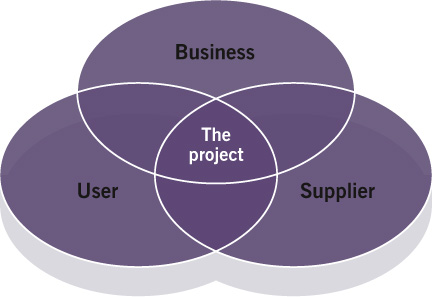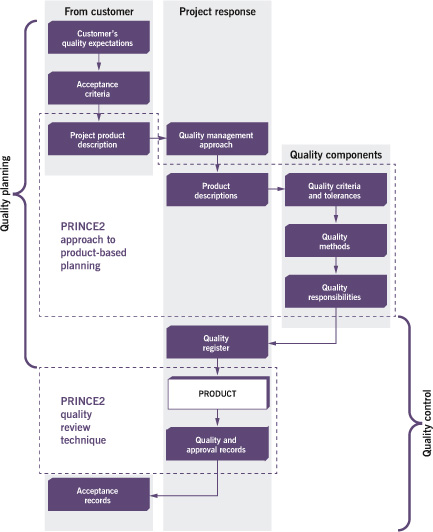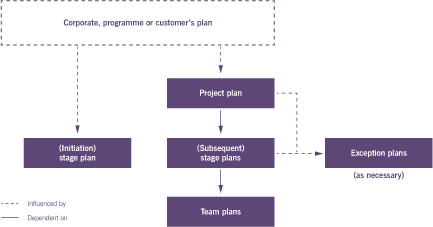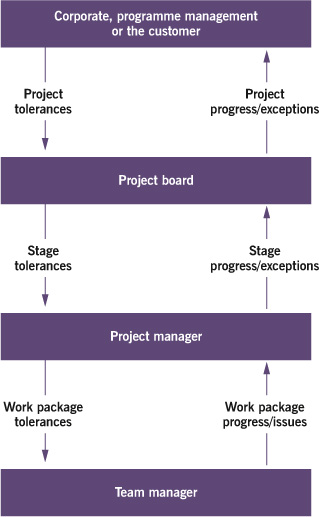4 Themes
The PRINCE2 themes describe aspects of project management that must be addressed continually as the project progresses through its lifecycle. For example, the business justification for the project will need to be updated and revalidated throughout the project lifecycle; change will take place and risks will need to be managed.
However, the strength of PRINCE2 is the way in which the seven themes are integrated, and this is achieved because of the specific PRINCE2 treatment of each theme (i.e. they are carefully designed to link together effectively).
The seven PRINCE2 themes are:
• Business case Explaining why the project has come about, and how the idea has been developed
• Organization Describing who will be in the project management team and their responsibilities
• Quality Describing what quality attributes are required of the products to be delivered
• Plans Outlining how the project is to proceed, how much resource will be required, and when things should happen (on the basis of a series of approved plans)
• Risk Addressing how uncertainty will be managed – the ‘what if?’ scenario
• Change Focusing on what impact any issues (arising as a result of change) may have on the project’s baseline plans and products
• Progress Addressing the ongoing viability of the project, monitoring its performance and determining whether and how it should proceed.
Each theme is described in more detail below, but in summary, the integrated set of PRINCE2 themes describe how:
• baselines (in the form of time, cost, quality, scope, benefits and risk) are established in the business case, quality, plans and risk themes. Managing changes to the baselines is covered by the change theme.
• the project management team monitors and controls the work as the project progresses (in the progress, quality, change and risk themes).
• the organization theme supports the other themes with a structure of roles and responsibilities that has clear paths for delegation and escalation.
Each theme contains suggestions for different tailoring options to implement the theme in practice, and identifies the minimum requirements to satisfy PRINCE2.
All the themes must be applied in a project but they should be tailored according to the risk, scale, nature and complexity of the project concerned. Tailoring enables the PRINCE2 themes to be adapted to create appropriate procedures and controls for the particular project, provided that:
• the PRINCE2 principles are upheld
• the minimum requirements in each theme are satisfied
• the purpose of each theme is not compromised.
![]()
Key message
The purpose of the business case theme is to establish mechanisms to judge whether the project is (and remains) desirable, viable and achievable as a means to support decision-making in its (continued) investment.
In PRINCE2, all projects must have a documented business justification. This sets out the reason for the project (its objectives) and also confirms whether the project is:
• desirable: the balance of costs, benefits and risks
• viable: able to deliver the products
• achievable: whether use of the products is likely to result in envisaged outcomes and resulting benefits.
The business justification is usually documented in a business case which provides the costs, benefits, expected dis-benefits, risks and timescales against which viability is justified and continually tested.
It is a PRINCE2 principle that a project must have continued business justification. This requires that the business justification is not just developed at the beginning of the project, but that it is kept under regular review and updated in response to decisions and events that might impact the desirability, viability or achievability of the project.
If the business justification ceases to be valid then the executive (see section 4.2) must halt or change the project, following review by the project board (see Figure 4.1).
To be following PRINCE2, a project must, as a minimum:
• create and maintain a business justification for the project; usually a business case (PRINCE2’s continued business justification principle)
• review and update the business justification in response to decisions and events that might impact desirability, viability or achievability of the project (PRINCE2’s continued business justification principle)
• define the management actions that will be put in place to ensure that the project’s outcomes are achieved and confirm that the project’s benefits are realized (PRINCE2’s continued business justification principle)
• define and document the roles and responsibilities for the business case and benefits management (PRINCE2’s defined roles and responsibilities principle)
• produce and maintain two products:
• business case (see section A.2)
• benefits management approach (see section A.1).
Continued business justification drives all decision-making by ensuring that the business objectives and benefits being sought can be realized. The business justification must be reviewed and verified:
• at the end of the starting up a project process by the project board in order to authorize project initiation based on a reasonable justification
• at the end of the initiating a project process by the project board in order to authorize the project
• as part of any impact assessment by the project manager of any new or revised issues or risks
• in tandem with an exception plan by the project board, in order to authorize the revised management stage and the continuation of the project
• at the end of each management stage by the project manager to determine whether any of the costs, timescales, risks or benefits need to be updated
• at the end of each management stage by the project board, to authorize the next management stage and the continuation of the project
• during the final management stage by the project manager, to assess the project’s performance against its requirements and the likelihood that the outcomes will provide the expected benefits
• as part of the benefits review (possibly by corporate, programme management or the customer), to determine the success of the project outcomes in realizing their benefits.
It is the responsibility of the executive to assure the project’s stakeholders that the project remains desirable, viable and achievable at all times.
![]()
Key message
The purpose of the organization theme is to define and establish the project’s structure of accountability and responsibilities.
Every project needs effective direction, management, control and communication (see section 1.5 for the role of senior management). Establishing an effective project management team structure and approach for communication at the beginning of a project, and maintaining these throughout the project’s lifecycle, are essential elements of a project’s success.
PRINCE2 identifies three principal categories of project stakeholders, each of which has a specific interest in, or viewpoint on, the project (see Figure 4.2). Each category of stakeholder has specific roles on the project in order to ensure that their interests are met. There may also be a wide range of other stakeholders with an interest in the project: for example, government, regulators and unions. The roles representing the stakeholders are as follows:
• Business The products of the project should meet a business need that justifies the investment in the project. PRINCE2 defines an executive role to represent business interests on the project.
• User PRINCE2 makes a distinction between the business interests and the requirements of those who will use the project’s outputs. PRINCE2 defines the senior user role to represent the user interest on the project.
• Supplier The provider of the skilled resources necessary to create the project’s output (product). PRINCE2 defines a senior supplier role to represent supplier interest on the project.
Summaries of the roles and their responsibilities can be found in Appendix C.
Some of the PRINCE2 responsibilities cannot be shared or delegated if they are to be undertaken effectively:
• The project manager and executive roles cannot be shared, i.e. the executive cannot also be the project manager and there cannot be more than one executive or project manager
• The decision-making accountability of the project manager and project board cannot be delegated.
To be following PRINCE2, a project must, as a minimum:
• define its organization structure and roles. This must minimally ensure that all of the responsibilities in PRINCE2’s role descriptions are fulfilled (PRINCE2’s defined roles and responsibilities principle)
• document the rules for delegating change authority responsibilities, if required
• define its approach to communicating and engaging with stakeholders
• produce and maintain two products:
• project initiation documentation (PID) (see section A.20)
• communication management approach (see section A.5).
![]()
Key message
The purpose of the quality theme is to define and implement the means by which the project will verify that products are fit for purpose.
Quality is concerned with ensuring that the project’s products meet business expectations and enable the desired benefits to be realized.
The ‘focus on products’ principle is central to PRINCE2’s approach to quality. It provides an explicit understanding of what the project will create (the scope) and the criteria against which the project’s products will be assessed (the quality).
PRINCE2 addresses the two activities of quality planning and quality control (see Figure 4.3):
• Quality planning is about defining the project’s products, with their respective quality criteria, quality methods and the quality responsibilities of those involved.
When quality planning is neglected, the people involved in the project may have conflicting views on the scope of the solution, what constitutes a successful result, the approach to be adopted, the extent of the work required, who should be involved, and what the roles are.
• Quality control focuses on the operational techniques and activities used by those involved in the project to check that the products meet their quality criteria and to identify ways of eliminating causes of unsatisfactory performance.
Capturing and acting on lessons contributes to the PRINCE2 quality approach, as it is a means of achieving continual improvement.
To be following PRINCE2, a project must, as a minimum:
• define its quality management approach. This approach must minimally cover:
• the project’s approach to quality control
• the project’s approach to project assurance
• how the management of quality is communicated throughout the project lifecycle
• the roles and responsibilities for quality management (PRINCE2’s defined roles and responsibilities principle)
• specify explicit quality criteria for products in their product descriptions (PRINCE2’s focus on products principle)
• maintain records to provide evidence that the planned quality activities have been carried out, and summarize those activities that are planned or have taken place in some form of quality register
• specify the customer’s quality expectations and prioritized acceptance criteria for the project in the project product description (see section A.21)
• use lessons to inform quality planning, the definition of quality expectations and quality criteria (PRINCE2’s learn from experience principle)
• produce and maintain two products:
• quality management approach (see section A.22)
• quality register (see section A.23).
![]()
Key message
The purpose of the plans theme is to facilitate communication and control by defining the means of delivering the products.
A plan enables the project team to understand:
• what products need to be delivered
• the risks (both opportunities and threats)
• any issues with the definition of scope
• which people, specialist equipment and resources are needed
• when activities and events should happen
• whether targets (for time, cost, quality, scope, risk and benefits) are achievable.
A plan provides a baseline against which progress can be measured and is the basis for securing support for the project, agreeing the scope and gaining commitment to provide the required resources.
PRINCE2’s principle of manage by stages reflects that it is usually not possible to plan the whole project from the outset. Planning becomes more difficult and uncertain the further into the future it extends. There will be a time period over which it is possible to plan with reasonable accuracy; this is called the ‘planning horizon’. It is seldom possible to plan with any degree of accuracy beyond the planning horizon.
PRINCE2 addresses the planning horizon issue by having both high-level and detailed plans. These are:
• a high-level project plan for the project as a whole. This will provide indicative timescales, milestones, cost and resource requirements based on estimates
• a detailed stage plan for each management stage, aligned with the overall project plan timescales. This plan must not extend beyond the planning horizon.
The very act of planning helps the project management team to think ahead to ‘mentally rehearse the project’. It is such rehearsal that enables omissions, duplications, threats and opportunities to be identified and managed.
The plans need to be produced at different levels of scope and detail. PRINCE2 recommends three levels of plan (project, stage and team) to reflect the needs of the different levels of management involved in the project (see Figure 4.4).
Should an exception occur, the affected plan is replaced by an exception plan.
To be following PRINCE2, a project must, as a minimum:
• ensure that plans enable the business case to be realized (PRINCE2’s continued business justification principle)
• have at least two management stages: an initiation stage and at least one further management stage. The more complex and risky a project, the more management stages that will be required (PRINCE2’s manage by stages principle)
• produce a project plan for the project as a whole and a stage plan for each management stage (PRINCE2’s manage by stages principle)
• use product-based planning for the project plan, stage plans and exception plans. It may be optionally used for team plans
• produce specific plans for managing exceptions (PRINCE2’s manage by exception principle)
• define the roles and responsibilities for planning (PRINCE2’s defined roles and responsibilities principle)
• use lessons to inform planning (PRINCE2’s learn from experience principle)
• produce and maintain the following products:
• project product description (see section A.21)
• product breakdown structure for each level of plan, with product descriptions (see section A.17)
• plans at project, stage and team levels, and exception plans as required (see section A.16).
![]()
Key message
The purpose of the risk theme is to identify, assess and control uncertainty and, as a result, improve the ability of the project to succeed.
All projects encounter uncertainty when trying to achieve their objectives. This uncertainty may arise from events inside or outside the organization. For example, there may be uncertainty about the ability of the organization to agree the scope of the project within certain timescales or the availability of critical resources. There might also be uncertainty about the final scope and shape of legislation with which a project is required to ensure compliance.
![]()
Definition: Risk
A risk is an uncertain event or set of events that, should it occur, will have an effect on the achievement of objectives. A risk is measured by a combination of the probability of a perceived threat or opportunity occurring, and the magnitude of its impact on objectives.
Risks can have either a negative or positive impact on objectives if they occur. PRINCE2 uses the terms:
• Threat For uncertain events that would have a negative impact on objectives.
• Opportunity For uncertain events that would have a positive impact on objectives.
These can impact the project’s objectives of delivering an agreed scope and benefits to an agreed time, cost and quality.
For risk management to be effective:
• risks that might affect the project achieving its objectives need to be identified, captured and described
• each risk needs to be assessed to understand its probability, impact and timing (proximity) so that it can be prioritized. The overall risk exposure needs to be kept under review, together with the impact of risk on the overall business justification for the project
• responses to each risk need to be planned, assigned to people to action and to own
• risk responses need to be implemented, monitored and controlled.
Information about risks must be communicated within the project and to stakeholders as a continual activity. Different organizations will have their own views on risk-taking that in turn dictate the overall amount of risk that they consider to be acceptable. This may be referred to as risk appetite.
PRINCE2 defines a number of different risk responses to opportunities and threats. These are as follows:
• Threats Avoid, reduce, transfer, share, accept or prepare contingent plans
• Opportunities Exploit, enhance, transfer (not often used), share, accept or prepare contingent plans
Definitions for each of these responses can be found in the glossary.
Not all opportunities may be taken up as there could be circumstances such as timing or cost which would have a negative impact on the project goals.
To be following PRINCE2, a project must, as a minimum:
• define its risk management approach, which must minimally cover:
• how risks are identified and assessed, how risk management responses are planned and implemented, and how the management of risk is communicated throughout the project lifecycle
• assessing whether identified risks might have a material impact on the business case (PRINCE2’s continued business justification principle)
• the roles and responsibilities for risk management (PRINCE2’s defined roles and responsibilities principle)
• maintain some form of risk register to record identified risks and decisions relating to their analysis, management and review
• ensure that project risks are identified, assessed, managed and reviewed throughout the project lifecycle
• use lessons to inform risk identification and management (PRINCE2’s learn from experience principle)
• produce and maintain two products:
• risk management approach (see section A.24)
• risk register (see section A.25).
![]()
Key message
The purpose of the change theme is to identify, assess and control any potential and approved changes to the project baselines.
Projects take place in their organizational environment and wider context, both of which change over time. It is rare that a project closes having delivered exactly what was envisaged when the project was initiated. It is often said that change is inevitable and this is certainly the case for long and more complex projects.
This means that projects need a systemic approach to the identification, assessment and control of issues that may result in change. Issue and change control is a continual activity, performed throughout the life of the project. Without an ongoing and effective issue and change control procedure, a project will either become unresponsive to its stakeholders or drift out of control.
In PRINCE2, changes are identified as ‘issues’. PRINCE2 uses the term ‘issue’ to cover any relevant event that has happened, was not planned and requires management action. Issues may be raised at any time during the project by anyone with an interest in the project or its outcome.
The different types of issue that need to be dealt with during a project are:
• request for change
• off-specification
• problem/concern.
These terms are defined in the glossary.
To be following PRINCE2, a project must, as a minimum:
• define its change control approach. This approach must minimally cover:
• how issues are identified and managed
• assessing whether identified issues might have a material impact on the business case (PRINCE2’s continued business justification principle)
• the roles and responsibilities for change control (PRINCE2’s defined roles and responsibilities principle), including a defined change authority
• define how product baselines are created, maintained and controlled
• maintain some form of issue register to record identified issues and decisions relating to their analysis, management and review
• ensure that project issues are captured, examined, managed and reviewed throughout the project lifecycle
• use lessons to inform issue identification and management (PRINCE2’s learn from experience principle)
• produce and maintain two products:
• issue register (see section A.12)
• change control approach (see section A.3).
![]()
Key message
The purpose of the progress theme is to establish mechanisms to monitor and compare actual achievements against those planned; provide a forecast for the project objectives and the project’s continued viability; and control any unacceptable deviations.
Progress is the measure of the achievement of the objectives of a plan. Controlling progress is central to project management, ensuring that the project remains viable against its approved business case. Progress control involves measuring actual progress against the performance targets of time, cost, quality, scope, benefits and risk. This information is used to make decisions such as whether to approve a management stage or work package, whether to escalate deviations, and whether to prematurely close the project and take actions as required. Progress can be monitored at work package, management stage and project levels.
Of PRINCE2’s seven principles, the principle of manage by exception is particularly important to the progress theme. An exception is a situation where it can be forecast that there will be a deviation beyond agreed tolerance levels.
Tolerances are the permissible deviations above and below a plan’s target for cost and time without escalating the deviation to the next level of management. There may also be tolerance levels for quality, scope, benefits and risk.
To be following PRINCE2, a project must, as a minimum:
• define its approach to controlling progress in the PID
• be managed by stages (PRINCE2’s manage by stages principle)
• set tolerances and be managed by exception against these tolerances (PRINCE2’s manage by exception principle)
• review the business justification when exceptions are raised (PRINCE2’s continued business justification principle)
• learn lessons (PRINCE2’s learn from experience principle).
• produce and maintain these products:
• issue register (see section A.12)
• product status account (if used) (see section A.18)
• quality register (see section A.23)
• risk register (see section A.25).
PRINCE2 provides progress control through:
• delegating authority from one level of management to the level below it
• dividing the project into management stages and authorizing the project one management stage at a time (PRINCE2’s manage by stages principle)
• time-driven and event-driven progress reporting and reviews
• raising exceptions (PRINCE2’s manage by exception principle).
The project’s controls should be documented in the PID.
The allocation of tolerances is outlined in Figure 4.5. Tolerances are either set by or delegated to the following management levels:
• Corporate, programme management or the customer sits outside the project but sets the overall requirements and tolerance levels for the project.
• The project board has overall control at a project level, as long as forecasts remain within project tolerance, and will allocate tolerances for each management stage to the project manager.
• The project manager has day-to-day control for a management stage within the tolerance limits laid down by the project board.
• The team manager has control over a work package, but only within the work package tolerances agreed with the project manager.





